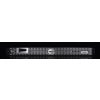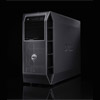 |
T is for tower and R is for rack, in these parallel, feature-laden low-cost servers from Dell.
Dell recently introduced several servers to reinforce its traditional strength in the lower end of the market. The PowerEdge R300 and T300 are very similar machines — one is a tower and the other is a rack server.
“The R300 and T300 are the industry’s highest performing one-socket quad-core servers,” said Armando Acosta, senior PowerEdge product line manager for Dell (Round Rock, Texas).
These units are designed primarily for small and midsize businesses, but they have enough horsepower to perhaps see some usage in a broader setting. At the same time, they are affordably priced. According to Gordon Haff of Illuminata (Nashua, N.H.), Dell is currently riding a fine line with such products between low cost and providing good-enough features to separate its products out from the competition.
|
Unsure About an Acronym or Term? |
“Low cost remains an important focus, as indeed it has to be in the über-competitive world of x86 servers,” said Haff. “But Dell has made recent decisions that show it’s willing to go beyond the absolute lowest R&D, minimalist delivery cost, and cheapest bill of materials when it makes sense to do so.”
T is for Tower
The PowerEdge T300 is the tower version. It has a 1-socket chipset with a choice of processors. This includes a quad-core Xeon 5400 series (up to 3.16GHz), a quad-core Xeon 3300 series (up to 2.83GHz), a dual-core Intel Core 2 Duo E6400 series (up to 2.13GHz), a Core 2 Duo E6300 series (up to 1.86GHz) and an Intel Celeron 445 (up to 1.86GHz) processor. Like its cousin the R300, the T300 also comes with a healthy amount of memory.
“The new R300 and T300 servers help companies handle memory-intensive applications by offering up to 24GB of memory — three times the memory capacity of competitive one-socket x86 systems,” said Acosta.
Dell is targeting them both beyond the realm of normal single-processor systems. Small businesses, as well as some midsize organizations, could find a use for either as a stable home for memory-intensive applications.
“Dell is expanding its services, server and storage offerings to meet the unique needs small and medium businesses,” said Acosta. “The T300 has industry-leading performance, so small and medium businesses no longer have to sacrifice server performance or reliability for an affordable price.”
The T300 can also pack in plenty of internal storage — up to 4 TB of SATA (160 GB, 250 GB, 500 GB, 750 GB and 1000 GB 7.2K drives) and 1.6 TB of SAS (73 GB, 146 GB and 300 GB 15K or 400 GB 10K drives). Dell PowerVault external storage arrays and tape drives can furhter supplement.
The server comes with five I/O slots. This includes two PCI Express x8 slots, two PCI Express x 4 slots, and one PCI-X 64-bit/133MHz slot. It also has more ports than you would expect in such a small box. In the rear it has two Gigabit NIC ports, two USB ports, one video connector and one serial connector. In addition, two USB ports and one video connector are in front, as well as an internal port for a USB drive.
|
Recent Snapshots
» Spotlight on Dell Read More Snapshots |
On the security front, Dell has added a locked-down internal USB port, chassis intrusion switch, locking bezels, and a built-in Trusted Platform Module (TPM) to handle authentication and encryption and prevent tampering.
“High-availability features include hot-plug hard drives and redundant power supplies to help increase uptime and prevent loss of data access,” said Acosta.
The T300 has a starting price of $699. That buys you a decent Intel Core 2 Duo E6305 processor with 1.86 GHz but only 512 MB memory, one 80 GB SATA hard drive and no OS. The processor is upgradeable, of course. Add $1,300 if you want the best quad-core Xeon chip (3.16GHz), the full amount of memory and 1.6 TB of internal storage for $8,951.
“The T300 tower server achieves up to 31 percent better performance compared to the HP ML310 G5 server, and up to 51 percent better performance than the IBM System X 3200,” said Acosta.
R is for Rack
While T stands for tower, R means rack in Dell’s new server naming convention. Any Dell rack or tower numbered 400 or lower means 1 socket. The R300 then is a single processor box like the T300. The middle zero means it is the first generation of that model and the last zero means it is Intel.
The R300 has much of the same specs as the T300. As mentioned above, it has up to 24 GB memory, similar processor choices, but only half the internal storage — up to 2 TB.
The basic rack version is little pricier than a simple tower. The R300 starts at $949. Fully loaded with a quad-core Xeon X5460 (3.16GHz), 24 GB RAM and two 400 GB SAS drives, it prices in at $5,806. Acosta reckons it stands up well against the competition.
“Using the quad-core Intel Xeon x5460 processor, the PowerEdge R300 achieves up to 26 percent better performance than the HP DL320 G5p, and up to 51 percent over the IBM System X 3250,” said Acosta.
The Dell PowerEdge R300 and T300 Close Up
| Name | R300 | T300 |  The R300
|
| Vendor | Dell | Dell | |
| Platform | x86 | x86 | |
| Dimensions | 1U rack | 17.94″ H, 8.27″ W, 24.01″ D | |
| Processor Details | a single quad-core Xeon 5400 series at up to 3.16GHz; a single quad-core Low Volt Xeon L5400 series at up to 2.33GHz; a single quad-core Xeon 3300 series at up to 2.83GHz; a single Core 2 Duo E6405 at up to 2.13GHz; a single Core 2 Duo E6305 at up to 1.86GHz; a single Celeron 445 at up to 1.86GHz | a single quad-core Xeon 5400 series at up to 3.16GHz; a single quad-core Xeon 3300 series at up to 2.83GHz; a single dual-core Intel Core 2 Duo E6400 series at up to 2.13GHz; a single Core 2 Duo E6300 series at up to 1.86GHz; a single Intel Celeron 445 at up to 1.86GHz | |
| Hard Drives | SAS:73 GB, 146 GB and 300 GB 15K or 400 GB 10K drives for up to 800 GB of internal storage SATA: 160 GB, 250 GB, 500 GB, 750 GB and 1000 GB 7.2K drives for up to 2 TB |
SAS: 73 GB, 146 GB and 300 GB 15K or 400 GB 10K drives for up to 1.6 TB maximum SATA: 160 GB, 250 GB, 500 GB, 750 GB and 1000 GB 7.2K drives for a maximum of 4 TB of internal storage |
|
| Operating Systems | Windows Server, Windows Small Business Server, Red Hat Linux, SuSE Linux | Windows Server, Windows Small Business Server, Red Hat Linux, SuSE Linux | |
| Configuration Options | For $949: Intel Core 2 Duo E6305 (1.86GHz), 512 MB RAM, 1 x 80 GB SATA, no OS For $5806; quad core Xeon X5460 (3.16GHz), 24 GB RAM, 2 x 400 GB SAS drives |
For $699: Core 2 Duo E6305 (1.86GHz), 512 MB memory, 80 GB SATA, no OS For $8951; quad core Xeon X5460 (3.16GHz), 24 GB memory, 4 x 400 GB SAS drives, 2x PERC 6/E SAS external RAID adapter |
|
| Availability | Now available | Now available | |
| Warranty | 3 years | ||



